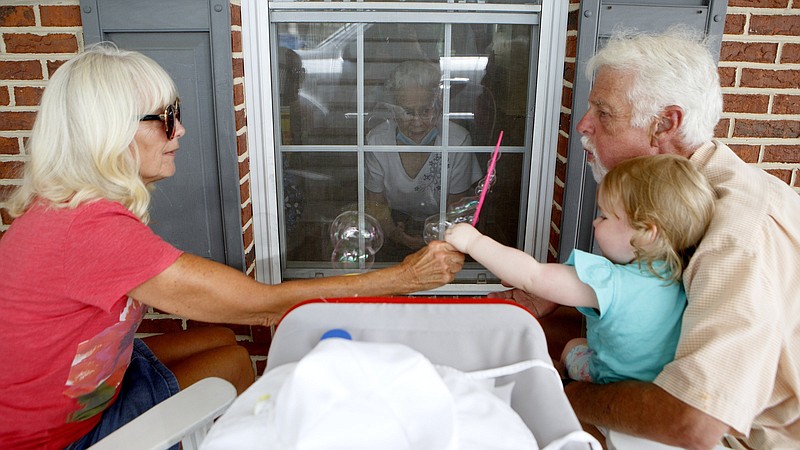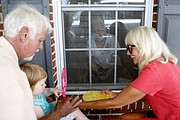Ruth Skates, or Mamaw Ruthie as her family calls her, peered from behind her face mask and through a window to watch as her great granddaughter, Lottie, blew bubbles on the front porch of the senior facility where she lives.
Lottie was in town to visit, and Patsy Evans - Lottie's grandmother and Skates' daughter - brought the toddler over with the hopes it would cheer Skates up.
Skates gets to sit outside in the back courtyard from time to time, but she's only left the facility once since the global coronavirus pandemic reached Chattanooga, and that was an extenuating circumstance - she needed to see an audiologist for her hearing aids.
Skates opted to live in an assisted living community rather than with her daughter for the social aspect. Before COVID-19, Evans would still visit about five times a week to spend time with her mother, take her shopping or go out to eat or to doctor appointments.
And while some senior living facilities in Tennessee are starting to allow limited visitation, many in the Chattanooga region - including Regency House in Hixson where Skates lives - are not.
The only way Skates can have visitors is from inside the lobby with a closed window separating her from her guests on the outside. That's how she celebrated her 97th birthday in April.
Shonie Harris, interim director at Regency House, said the facility has been lucky to avoid any COVID-19 cases so far.
The pandemic has been hard on residents and staff, Harris said, but Regency's visitation policy is in line with the state's guidelines to keep residents safe from the highly contagious coronavirus - which has killed at least 43,000 long-term care residents and staff nationwide, or over a third of known COVID-19 deaths in the United States, according to the Kaiser Family Foundation.
"When the residents are sad, we are sad and try to do our best to make them feel better," Harris said. "We as a staff miss the families visiting as much as they miss being able to come visit."
Experts say the death toll from COVID-19 in long-term care facilities is an undercount because states report figures differently, and not all share their data publicly. In many states, more than half of coronavirus deaths are connected to long-term care facilities, according to the AARP.
Evans said she understands the visitation policy "to a point," given that the less people come in and out of the facility, the less chance there is of bringing in COVID-19. But she can't help thinking there's a better way to allow visitors, especially since staff come and go from the facility every day.
"I just don't feel like they're taking into consideration the hardship that they're putting on the residents of these places," Evans said.
A unique set of challenges
Assisted living centers face many of the same issues related to COVID-19 as nursing homes and other long-term care facilities, but they also have their own specific challenges.
Like nursing homes, residents in assisted living facilities are among the most vulnerable to COVID-19, since more than half of the population is over 85 years old, and many are living with underlying health conditions, according to the American Health Care Association and National Center for Assisted Living.
Generally, assisted living communities offer supervised care for people who need some assistance with daily life activities but who do not require round-the-clock skilled nursing care, like individuals in nursing homes. Assisted living centers can't provide medical care, so either an outside service has to come in or the patient must leave in order to see a doctor.
Dr. Alycia Cleinman, a geriatrician at the CHI Memorial Center for Healthy Aging, said about 50% to 60% of her patients live at long-term care facilities, and she's watched many of them decline in health throughout the pandemic due to delays in medical care.
"A lot of people are three to four months behind in their routine labs. In the elderly, that can be very detrimental," Cleinman said.
Although access is slowly improving, there are still some facilities that won't allow residents to leave for medical appointments. Others let residents go to the doctor but may require them to isolate for two weeks afterward.
"Which causes more burden on them and more isolation, so they're almost being punished for adhering to treatment," Cleinman said, adding that these inconsistencies in how long-term care facilities handle visitation pose a big issue.
"Some implemented policies right away, some have lightened up, some are still very strict," she said. "We have to find some uniform position that will allow people to be safe but also allow some sort of socialization among residents and allow them to seek medical care."
One challenge in assisted living is that the facilities typically have smaller staffs and higher resident-to-employee ratios, because residents need less one-on-one care. That means there are fewer people to help with new demands brought on by COVID-19 - such as extra cleaning, feeding each resident in rooms and making special accommodations for visitation or off-site trips.
And unlike nursing homes - which have received federal funding, personal protective equipment and testing priority to help combat the pandemic - assisted living communities in the United States have not received any direct federal funding or assistance.
A National Center for Assisted Living member survey conducted in June found that more than half of assisted living communities had less than two weeks worth of PPE and struggled to find needed supplies. Over 70% were reusing PPE in accordance with U.S. Centers for Disease Control and Prevention strategies to conserve limited resources, and nearly half of the facilities had been forced to solicit donations from the public.
"As many states reinstitute public gatherings as well as plan guidance on 'opening up' long term care facilities to visitation, this is a critical time period to ensure our assisted living communities are equipped to keep COVID-19 out of their buildings. Our organization has requested $5 billion in emergency funding from the Department of Health & Human Services (HHS) to help pay for PPE supplies as well as expanded testing and additional staffing," said Scott Tittle, executive director of the National Center for Assisted Living, in a statement.
In a letter to HHS, Tittle said access to frequent testing with rapid results was essential to ensure safety at the facilities given that some people with COVID-19 don't show symptoms and can unknowingly spread the virus to others.
Tennessee Gov. Bill Lee made it a goal to get all the facilities tested by June, but the process has been slow.
Regency House staff and residents were tested in late May, Harris said. They're on the waiting list to be tested again, although Harris doesn't know when.
A new normal
Cleinman said "it's a fine balance" weighing the risk of COVID-19 with the health and social needs of older adults, who typically have multiple chronic diseases and often grapple with loneliness and experience higher rates of depression.
She's been encouraging her patients who aren't allowed out to interact with their family through the window and over the phone. However, that doesn't work for everyone.
Skates wears hearing aids and has dementia, so Evans said it's hard to communicate with her over the phone. Aside from the hearing issues, if Skates is having a bad day cognitively, Evans said it's like "talking to a brick wall." And the window visitation doesn't help, because the window is closed, and they still have to use a phone to talk.
"That's why it's so much better to be with her face-to-face, because you can somewhat try to reason with her, and if you're not able to reason with her, you can just sit quietly with her," Evans said.
Luckily Skates was having a good day when Lottie visited, but Evans said sometimes visits are awkward and discouraging.
"When you leave there, you feel like you've done more harm than good, because she's going, 'Why don't you just come in? I don't understand why you can't come in, and why can't you take me out,'" Evans said. "I go less and less to visit, because I feel like I'm not really helping her. I feel like I'm making her more agitated."
Tennessee began allowing some forms of limited visitation at long-term care facilities starting June 15, but facilities need to meet certain criteria: testing of all staff and residents at least once, no new COVID-19 cases in the last 28 days, compliance with Board for Licensing Health Care Facilities regulations and infection control guidelines and overall stability of the disease burden present in the community where the facility is located.
Harris, interim director at Regency, said the facility can't meet those criteria with the current trajectory of COVID-19 in Hamilton County and the surrounding areas, which the New York Times ranked as No. 2 in the country for growth rate in COVID-19 deaths last week.
Evans admits she's a "helicopter daughter," meaning she has a tendency to worry and wants to check on her mother often. She believes that Regency is a "nice place," and her mother is well cared for there - but the workers are strangers to her.
"I want to go make sure my mother is living in a clean environment, has clean clothes, she's entertained and feeling OK, and there's only so much that employees in a facility can and will do," she said.
Evans knows other families in the same boat. She hears stories of their loved ones who are losing weight, confused or sleeping all day now that their routine is off and there's little reason to leave their rooms.
"My mother just has so little stimulation now that it's dragging her down and down and down," Evans said. "The visits are important more to me. I think she needs just more interaction with anybody."
Cleinman is encouraging seniors to sit outside - at a distance from others - and to go to safe public places during certain times of day when face masks are required and crowds are small.
"We can't keep them locked in their rooms all the time, because we have no idea when this will end," Cleinman said. "We have to come up with some uniform plan or else we're going to see a large physical and cognitive decline in these patients in these facilities as a result. People don't just suffer from coronavirus, there are a lot of other medical issues that can develop."
Cleinman believes the ideal situation would be to allow some small group activities, going to places that are known to be safe and allowing limited visitation with a person who has been practicing safe social distancing outside of the facility - working from home and not going to restaurants or social gatherings - much like the visitation policies for the hospitals. She does not think it's safe to open dining halls.
Evans said the worst part is that people inside senior living facilities don't get to choose to self quarantine. Her mother used to run a business, and now she's having to be treated like a child.
"I don't mean that she's been treated badly, but she's been treated like a child - forced to quarantine," Evans said. "Everybody else's lives are moving on, and hers is not. Hers is stopped, and it's just really sad.
"I know they're trying to keep them safe physically, but at what cost? Because their mental health is just as important as their physical health," she said. "It's hard on us, too, but that's secondary, really. We need to look out for them."
Contact Elizabeth Fite at efite@timesfreepress.com or follow her on Twitter @ecfite.

